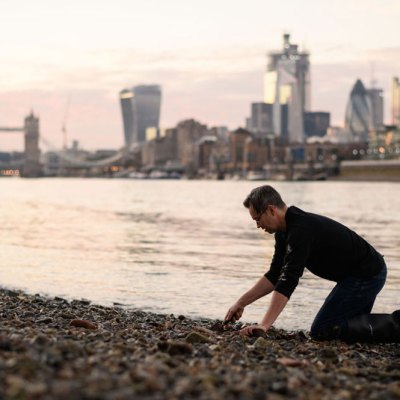It’s a foul May morning in Ponders End, and I am standing by the side of the Lea Navigation, a canalised stretch of the river Lea, staring at the decaying carcass of a cigarette machine. Three or four crayfish are scuttling around amid a tangle of wires; they’ve made a home within this mass of rusted metal, which until a few moments ago was lying at the bottom of the canal. Alongside me is a father-and-son duo from East London – Johns Snr and Jnr – who sport a ‘London Magnet Fishing’ logo on their matching hoodies. I’ve just helped them haul this ancient fag machine out the drink.
Magnet fishing is a younger, aquatic cousin to metal detecting – the magnet fishers I speak to all say that they began within the last five years, but in that short time this pursuit has mushroomed in popularity. Essentially, you tie an end of rope to a powerful (generally neodymium) magnet, fling it into a body of water, and see what sticks. And what sticks is mostly rubbish – the proverbial shopping trolley is, I’m told, a rarer find than one might expect, but laughing gas canisters and discarded home appliances are a regular occurrence. Yet for many magnet fishers, pulling up this kind of detritus is partly the point. Trooping out twice a week, the London Magnet Fishing team – who bought their first magnets at the start of 2020, but only became regular ‘dippers’ during last year’s lockdown – measure their success in tonnage. After each session, a scrap-metal collector arrives to take the haul away for recycling – and the Johns are careful to show, at the end of each of their weekly YouTube videos, that they have removed all sign of their presence from the spot they have fished. ‘That’s one less fag machine clogging up the canal,’ John Snr says, loading it onto the scrapper’s truck. ‘Can you imagine getting your boat stuck on this?’
Reclining fag machine. Photo: Sam Reilly

Beyond the ecological impulse, there’s the simple thrill of the chase. I’ve explained to John Snr on the phone that I’m interested in the history of the objects they’ve uncovered, so he and his son have brought along one their proudest finds to show me: part of what they take to be a Second World War-era bayonet. Others, too large to carry back to the canal, include a decorative button that once belonged to a bridge, and which has been electrolysed for use as a home decoration; a safe, in which was found a bank card with an expiry date of 1989; and a cast-iron Victorian bollard, which the Johns’ scrap-driver has had cleaned of rust to display in his garden. Nigel Lamford, who runs the Northants Magnet Fishing group and has fished across large swathes of England, tells me of a cannonball he found near Fotheringhay Castle, where Mary, Queen of Scots was imprisoned in the 16th century. With most urban waterways having been constructed in the 18th and 19th centuries, however, it’s unlikely that anything will be dredged up to match such dectorists’ discoveries as the Galloway or Staffordshire Hoards. Lamford cautions would-be ‘trophy hunters’ that they’re not going to make any money out of this – ‘Just do it for the love of the hobby,’ he says.
When magnet fishing does make the news, it tends to be for rather different reasons. There have, for instance, been several instances of the police closing roads while they deal with a piece of unexploded ordnance, fished up from the depths. There is a clear code of honour among magnet fishers – whenever such items are found, it is imperative that the police are called. But sensational as it may seem to the uninitiated, John Snr explains that sitting by the side of a canal waiting for the bomb disposal unit to rock up can very quickly become a nuisance. Lamford agrees – ‘Nothing but trouble,’ he says. Sure, weapons are in some respects part of the fun – there are now numerous magnet-fishing groups on Facebook and YouTube, and their feeds are in large part composed of pictures of rusted guns, captioned with pleas for help from the community to identify them. In 2017, magnet fishers in Liège, Belgium, found weapons and munitions related to the crimes of the Brabant killers; at Ponders End, John tells me that the notorious Kray twins were known to operate nearby. But in many ways guns are no different to bollards or bridge ornaments; everything that is pulled out of the canal can provide a direct, material connection with local urban history. ‘What I love most,’ John says, ‘is that when you cast your magnet out, you just have no idea what you might drag back in.’
Legally, magnet fishers find themselves in slightly murky waters. The sport has recently been legalised in Scotland, but in England and Wales the Canal and River Trust (CRT), which oversees some 2,000 miles of waterways, prohibits it; the trust points to a byelaw of 1965 which forbids any person without permission from ‘dredg[ing] or remov[ing] coal or any other material from the canal’, on pain of a £25 fine. One harbour master for the London & South East Office tells me that there are plenty of magnet fishers who do not clear up after themselves as assiduously as others. Despite a grassroots push from magnet fishers themselves, who in the last year or so have set up Facebook groups such as ‘Dippers and Scrappers’ with the express purpose of connecting fishers with scrap-drivers, piles of junk can still occasionally be found by the side of the canal.
But the harbour master also suggests that the CRT wants particularly to work more closely with magnet fishers; he points to community events put on by the trust such as the dewatering of the Hertford Union earlier this year, at which all sorts of objects – from household Buddhas to Second World War helmets – were recovered by volunteers. Lamford, for his part, says that ‘there’s a group of us working with the CRT to try and get it legalised – like they have in Scotland’. There are plenty who take a less dim view than the CRT – Lamford points to a boater who thanked him profusely for uncovering an unexploded grenade from near his awning, while at Ponders End, an angler pitches up nearby us, explaining that the fish are more active after the bottom of the canal has been disturbed.
Simon Maslin, a finds liaison officer for the Portable Antiquities Scheme, can’t be alone in finding the hobby ‘perplexing’, stressing how rare it is for any objects of serious archaeological interest to be recovered. And yet it was on Maslin’s beat in Surrey that the most significant ‘catch’ in the UK occurred in 2018. On a river outside Woking, a first-time magnet-fisher discovered an Anglo-Saxon spearhead – dating back probably to the late sixth or early seventh century, to judge from the shape of the socket. Maslin suggests that, ‘in pre-Christian times, it was likely thrown into the water as a votive offering to the gods.’
Early medieval iron spearhead. Photo: Surrey County Council; published under a Creative Commons license (CC BY)

As we wait by the side of the canal for the scrapper to rock up, John Snr muses on the motives of whoever disposed of the cigarette machine. ‘There’s no pubs for miles round here,’ he says. ‘Why – and how – would anybody lug that thing all the way over here just to chuck it?’ By the time the scrap collector arrives, John has put two and two together – an old iron pallet truck was dredged up just before I arrived, which ‘must have been from the same time’. In all likelihood, then, the thing was nicked a decade or two ago, stripped of its cigarettes and then wheeled here on the truck. It may not be a Saxon spearhead, but nonetheless, there’s a story in this ugly relic of the recent past. As John Jnr says, ‘that fag machine – that’s history, isn’t it?’


